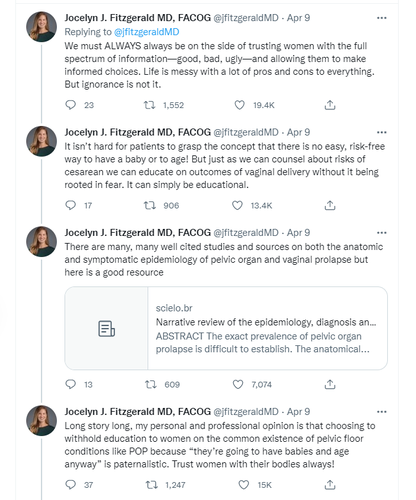Dr. Jocelyn J. Fitzgerald MD, a urogynecology and pelvic reconstructive surgeon, went viral with her brutally honest tweets about the ‘patriarchy’ ‘withholding information’ from women about how vaginal births can later cause pelvic organ prolapse. In my interview below, she reveals more about the condition and how most women who need surgery for POP are in their 50s and 60s.



What particularly inspired you to tweet about POP last week? Your very honest words really indicated your frustration. And when you say the patriarchy, why do you think some male doctors would deliberately withhold this information from women?
I tweet about POP frequently, but I had a day/week in the office where patients (mostly younger, in their 40s) were totally distraught over the fact that ‘nobody had ever told them this could happen’. I had just heard it one too many times and was tired of the way we dance around talking about prolapse. Prolapse is when your vagina falls out, and it is mostly due to the trauma of vaginal deliveries. That’s the simplest way of saying it.
It is really upsetting to me how few people know what the definition of ‘the patriarchy’ is. The patriarchy is NOT men! Many women uphold the patriarchy all the time. The definition of patriarchy is ‘a social system in which power is held by men, through cultural norms and customs that favor men and withhold opportunity from women’. In this tweet the patriarchy is the system we are in that withholds the realities of birth from women or birthing people out of concern that it might make them reconsider motherhood. It is a system that doesn’t give women all of the information about their bodies because we may not trust them to make their own decisions.
Pelvic organ prolapse (POP) occurs when the tissue and muscles of the pelvic floor no longer support the pelvic organs resulting in the drop (prolapse) of the pelvic organs from their normal position. The pelvic organs include the vagina, cervix, uterus, bladder, urethra, and rectum (fda.gov)
Why are women not warned more about POP due to vaginal birth vs. the well-known risks of caesarean births?
This is a very complicated question but I believe is related to a combination of shame, ‘not wanting to scare women’ and also simply time and resources for education. Obstetricians have an enormous job of preparing patients for the many other risks of birth. C sections also come with considerable risks. There is no easy or completely safe way to have a baby.
I have to ask, can a vagina technically fall out of a woman’s body? How far can the organs fall due to POP?
Yes, it can. The largest prolapse I have ever seen was 15cm outside of the body.
What are the warning signs or symptoms that you may have POP? And when should you call your OB-GYN?
The most common symptom is a bulge in the vagina or pelvic pressure. Heaviness sometimes, and occasionally some pain with sex, but prolapse rarely causes pain. Usually people ‘feel something coming out’. Call your OB-GYN when it bothers you.
Is an overactive bladder a symptom of POP?
Yes, it often is.
How can women expect the condition to develop?
Usually it is a persistent bulge.
What do you suggest to help women deal with POP before surgery is recommended? Kegels etc.
If their prolapse is above the hymen, pelvic floor physical therapy can help it move back 1-2 centimeters. Otherwise, a pessary (which is a rubber circle) for support.
Do the majority of women get POP due to childbirth?
Yes, the majority of patients with POP have had vaginal deliveries. That is the biggest risk factor. But there are other risk factors such as obesity, constipation, chronic cough, and connective tissue disorders.
Is it possible that a woman had POP after childbirth but didn’t know at the time? And that it got better naturally, i.e. can breastfeeding help fix the pelvic floor issue, or is the damage done?
A lot of POP is totally asymptomatic. Most women notice it when it reaches the hymen or goes beyond the hymen. The damage is not always done, 1/3 gets better, 1/3 stays the same but 1/3 gets worse. Breastfeeding has not been shown to help fix pelvic floor issue – in fact breastfeeding can cause a lot of pelvic floor laxity. The good news is that this laxity is reversible after you are done breastfeeding, and that breastfeeding is not associated with prolapse long term.
Can POP also occur closer to midlife as a result of childbirth years earlier, which may have only started to weaken the pelvic floor back then?
Yes, that is correct. The tissue changes from aging usually are cumulative which can lead to prolapse becoming symptomatic after menopause.
In your experience, roughly what percentage of patients who have POP have had vaginal births?
I would say over 90 percent.
I assume POP is caused by pressure on the organs during pregnancy, not just during a vaginal birth. Are women who have had caesarean births still at a risk of getting POP?
Yes, women who have cesareans are still at risk, but their risk of POP specifically is significantly lower.
Is POP more common in women who have babies later in life, when their pelvic floor may already be weakening?
Yes.
How common is it for women in midlife who haven’t given birth to get POP, through ageing or menopause, and why?
There are not a lot of studies on this but there is some data that 6-9% of nulliparous women [a woman who hasn’t given birth] will have symptomatic POP. This is most usually associated with obesity and constipation.
In summary, would you say that the majority of women who experience POP are in their 50s and 60s but had vaginal births years before?
Yes, that is correct. The majority of women become symptomatic after menopause in their 50s and 60s.
What is the average age of women who come to you for surgery for POP?
Between 50-60 years old.
What will a woman be experiencing to be recommended surgery?
The key is that the prolapse needs to be ‘bothersome’ to the patient, they decline or cannot use a pessary, and they are usually at stage 2 or greater.
Please describe the kind of surgery can help fix POP.
This is a very complex answer but briefly: there are obliterative procedures (which shorten and tighten the vagina significantly – these patients cannot be desiring of penetrative intercourse); native tissue repairs (mostly done vaginally) where the vagina is resuspended to ligaments in the pelvis; mesh augmented repairs which are usually done in a minimally invasive fashion called a sacrocolpopexy, and these can all be with or without a hysterectomy.
What benefit can a women expect to feel from the surgery in how she feels?
It is important to define her goals and expectations beforehand, but usually getting rid of the bulge is the most important to people.
What is the recurrence rate of after surgery?
This depends on how you define recurrence. Like most reconstructive surgeries, aging and time can bring the prolapse back. Approximately 10-30% of women who have a prolapse surgery will need a second surgery in her lifetime.
Are there any side effects from the surgery?
There are definitely risks to all of the surgeries, if that’s what you are asking. Side effects can include pain, particularly with intercourse but this is overally fairly rare, around 10%.
Can physical therapy help before or after surgery?
Most studies show there isn’t a ton of benefit specifically for prolapse surgery but it absolutely cannot hurt in terms of improving overall pelvic floor function.
Is it most commonly the vagina that prolapses? How common is it for other pelvic organs to prolapse – the cervix, uterus, bladder and rectum?
The vagina never prolapses alone – it is the vaginal skin with a pelvic organ behind it – either the cervix, uterus, bladder, rectum, or a combination of these is prolapsing.
Do you operate on all organs affected by POP?
Yes, with the caveat that rectal prolapse and Rectocele are not the same thing. Rectocele is when the floor of the vagina is damaged so the rectum bulges under the vagina. Rectal prolapse is when the rectum comes out through the rectal opening. Rectal prolapses are usually operated on by Colon and Rectal Surgeons.
Does constipation lead to POP of the rectum, or is this still related to vaginal birth?
Both constipation and vaginal deliveries can contribute to rectocele.
Is POP preventable? Can better education about it prevent it leading to surgery or is it just an unavoidable natural process for some women?
The best ways to prevent POP is to modify risk factors like constipation or obesity, or chronic cough from smoking, or example. Obviously choosing not to become pregnant would also be a way to decrease risk.
At what point/age do you think women should be warned about POP by their doctor?
I think it should simply be a part of health or sexual education in school. I think if a patient is old enough to see a gynecolgist that education about gynecologic disease can be done. We teach people about the symptoms of a lot of diseases that never happen to them, and POP is common.
What can women in midlife say to educate their daughters about potential POP? Can they prevent it somehow?
See above for the prevention question. I recommend the Voices for PFD handouts.
Dr. Jocelyn J. Fitzgerald is an Assistant Professor of Obstetrics, Gynecology, and Reproductive Sciences at the University of Pittsburgh Medical Center Magee Womens Hospital, Division of Urogynecology and Reconstructive Pelvic Surgery.
*Please note, this article is for informational purposes only. As with all medical issues, speak to your own doctor to make an informed decision about your health.




